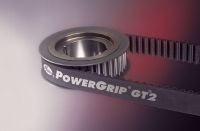Gates Offers Belt Drive System Solutions

From system design and component selection to prototyping and delivery, design engineers are charged with ensuring efficiency, hitting cost targets and delivering systems that perform. In a recent project to design a human-powered boat that could withstand a 3,000-mile ocean crossing, Gates was called in to review the design and offer key component recommendations. After devising a plan to pedal across the Atlantic and raise $250,000 for charity, two young engineers from the U.K. named Mark Byass and Mike Sayer enlisted a team of experts in boat design, fiber usage, ergonomics and hydrodynamics to design the watercraft. It's called Torpedalo.
Gates product application engineer Dan Parsons reviewed the designs and made key recommendations including the idea of eliminating the gearbox and using narrower belts in each of the two stages, making the system lighter, simpler and more efficient. Each stage of the synchronous belt drive is ~98 percent efficient, for a total estimated drive system efficiency of 96 percent. That means a smoother ride for the crew. This process was developed using Gates Design Flex Pro software, a design program that helps design engineers, maintenance engineers and power transmission distributors find solutions to fit the parameters of their belt drive systems. In addition to providing a fast, accurate way to design two-point drives from scratch, it allows the customer to determine proper belt installation tension, calculate belt pull, determine the belt horsepower capacity, show V-belt and synchronous belt options, estimate the energy savings of a synchronous belt drive compared to a V-belt drive, estimate the cost savings of replacing roller chain with a Poly Chain GT belt drive and compare noise levels of various Gates synchronous belt drives.
Design Flex Web, the program's online counterpart, offers all of the functionality of Design Flex Pro plus easy access from your browser. For multi-point or complex serpentine belt drives, customers can utilize Design IQ software.





